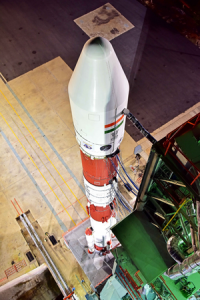India begins 2024 with PSLV rocket lifting off with XPoSat IANS Updated: January 1st, 2024, 09:33 IST in National , Prime News , Sci-Tech 0 Pic – IANS Share on Facebook Share on Twitter Share on WhatsApp Share on Linkedin Sriharikota : On the first day of the calendar year 2024, India’s Polar Satellite Launch Vehicle-C58 (PSLV-C58) Monday morning lifted off with the country’s X-ray Polarimeter Satellite (XPoSat) with 10 other payloads. The 44. 4-metre tall PSLV-C58 rocket with a lift off mass of 260 ton carrying XPoSat and 10 other experimental payloads on its fourth stage blasted off from the first launch pad at the Satish Dhawan Space Centre (SDSC) here at 9:10 am.
Also Read NIA scaled up crackdown on terror networks in 2023 14 hours ago Data-driven hiring practices, nearly double-digit pay hikes to mark HR ways in 2024 14 hours ago PSLV-C58/XPoSat Mission: Lift-off normal 



Interestingly, this is the first space mission for ISRO January 1 for the Indian Space Research Organisation (ISRO). At about 21 minutes into its flight, the rocket will orbit XPoSat at an altitude of about 650 km. Subsequently, the rocket’s fourth stage will be restarted twice to reduce the orbit into a 350 km circular orbit to maintain in 3-axis stabilised mode for Orbital Platform (OP) experiments.
The PSLV Orbital Experimental Module-3 (POEM-3) experiment will be executed, meeting the objective of 10 identified payloads, supplied by the ISRO and the Indian National Space Promotion and Authorisation Centre (IN-SPACe), the Indian space agency said. In its normal configuration, the PSLV is a four-stage/engine expendable rocket powered by solid and liquid fuels, alternatively, with six booster motors strapped onto the first stage to give higher thrust during the initial flight moments. The ISRO has five types of PSLV rockets — Standard, Core Alone, XL, DL, and QL.
The major difference between them is the use of strap-on boosters which, in turn, largely depends on the weight of the satellites to be orbited. The PSLV uses 6,4,2 solid rocket strap-on motors to augment the thrust provided by the first stage in PSLV-XL, QL & DL variants, respectively. However, strap-ons are not used in the core-alone version (PSLV-CA).
The XPoSat is the first dedicated scientific satellite from the ISRO to carry out research in space-based polarisation measurements of X-ray emission from celestial sources. The satellite configuration is modified from the IMS-2 bus platform. The configuration of the mainframe systems is derived based on the heritage of IRS satellites.
It carries two payloads, namely POLIX (Polarimeter Instrument in X-rays) and XSPECT (X-ray Spectroscopy and Timing). The POLIX is realised by the Raman Research Institute and XSPECT is by the Space Astronomy Group of the U. R.
Rao Satellite Centre (URSC). According to the ISRO, the three objectives of XPoSat are: (a) To measure polarisation of X-rays in the energy band 8-30keV emanating from about 50 potential cosmic sources through Thomson Scattering by POLIX payload. (b) To carry out long-term spectral and temporal studies of cosmic X-ray sources in the energy band 0.
8-15keV by XSPECT payload and (c) To carry out polarisation and spectroscopic measurements of X-ray emissions from cosmic sources by POLIX and XSPECT payloads, respectively, in the common energy band. After orbiting the XPoSat in 650km, the rocket’s fourth stage — PS4 stage — will be lowered to 350km, about 9. 6 deg orbit, by restarting it twice.
The left-out propellant in the PS4 will be disposed of through the main engines as a precursor to enabling the safety of the PS4 stage in atmosphere re-entry experiments planned in future. The oxidiser will be let out first followed by fuel in a predetermined sequence of operations. The existing scheme of spent stage passivation by venting the tank pressure will also be active.
Post passivation of PS4, the control of the stage is transferred to the POEM Avionics, the ISRO added. The POEM is configured as a 3-axis stabilised orbital platform for conducting experiments to space qualify systems with novel ideas. The PS4 Stage Orbital Platform Electrical power requirements are catered by a Flexible Solar Panel in conjunction with 50Ah Li-Ion battery in battery tied configuration.
The orbital platform consists of avionic systems to take care of navigation, guidance, control and telecommands and Orbital Platform Attitude Control System to cater to control of the platform to test the payloads, the ISRO said. The 10 payloads are from TakeMe2Space, LBS Institute Technology for Women, KJ Somaiya Institute of Technology, Inspecity Space Labs Private Ltd, Dhruva Space Private Ltd, Bellatrix Aerospace Private Ltd (two payloads) and three payloads from the ISRO. IANS Tags: ISRO PSLV XpoSat Share Tweet Send Share Suggest A Correction Enter your email to get our daily news in your inbox.
Leave this field empty if you’re human:.
From: orissapost
URL: https://www.orissapost.com/india-begins-2024-with-pslv-rocket-lifting-off-with-xposat/



